Downtown Flemington, part two
John C. Hopewell
From about 1855 until his death in 1888, a one-time hatter’s apprentice brought the village of Flemington into the modern era by providing an improved public water system, street lighting with gas instead of candles, a functioning fire company, improved streets and sidewalks, and more.
This is chapter two of my new series I am calling “Downtown Flemington.” (I have written about places and events in Flemington before, which can be found by clicking on Localities in the right column and scrolling down to Flemington.) In chapter one, “A Store, A Bank, A Mansion,” I described a part of the history of the Fisher-Reading Mansion and the ownership of an old store next to the Union Hotel—a building that will be dramatically changed before long. This was a prelude to the life and concerns of John C. Hopewell.
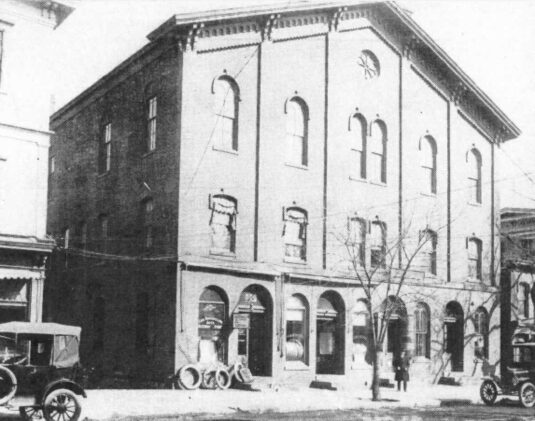 In an earlier article, “Coming into the Station,” I described a property shown on the Beers Atlas of 1873 belonging to “J. C. Hopewell,” located across from what is today the Dvoor Farm on Mine Street. The detail from the Raritan Township map showed “J. C. Hopewell” at the end of a long lane. It took me a little while to realize that John C. Hopewell lived elsewhere in Flemington. While looking for the location of his house, I came upon the fact that he was responsible for construction of the beautiful old bank building on Main Street, pictured here as it appeared around 1902.
In an earlier article, “Coming into the Station,” I described a property shown on the Beers Atlas of 1873 belonging to “J. C. Hopewell,” located across from what is today the Dvoor Farm on Mine Street. The detail from the Raritan Township map showed “J. C. Hopewell” at the end of a long lane. It took me a little while to realize that John C. Hopewell lived elsewhere in Flemington. While looking for the location of his house, I came upon the fact that he was responsible for construction of the beautiful old bank building on Main Street, pictured here as it appeared around 1902.
I should note that a typical biography would leave out some of the surrounding local history and lists of people involved in the same associations. However, this is not intended to be a typical biography, but rather a look at the town of Flemington by means of the biography of an individual.
Hopewell’s Early Years
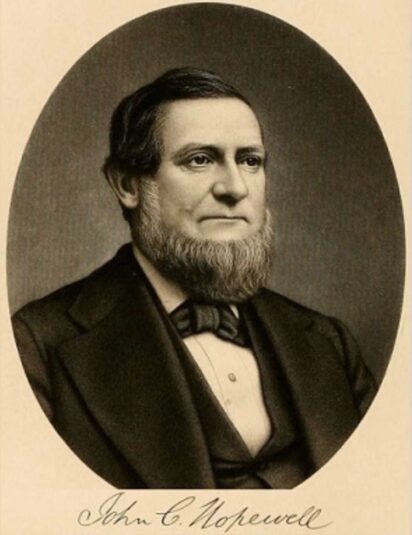 In James P. Snell’s History of Hunterdon County, a few biographies are included, the first being Charles Bartles, Esq., probably the richest, most influential man in Flemington during the 19th century. The next biography is that of John C. Hopewell, from whence comes this portrait.1 Despite the fact that Hopewell was still alive when Snell published his History of Hunterdon, he did not provide us with Hopewell’s middle name, and I have not found it either. (I have also not found a portrait of Mrs. Ann Housel Hopewell, which is disappointing.)
In James P. Snell’s History of Hunterdon County, a few biographies are included, the first being Charles Bartles, Esq., probably the richest, most influential man in Flemington during the 19th century. The next biography is that of John C. Hopewell, from whence comes this portrait.1 Despite the fact that Hopewell was still alive when Snell published his History of Hunterdon, he did not provide us with Hopewell’s middle name, and I have not found it either. (I have also not found a portrait of Mrs. Ann Housel Hopewell, which is disappointing.)
Despite having the same name as one of the towns located in the original Hunterdon County (which included Mercer County), John C. Hopewell was not a Hunterdon native. He came to Flemington from Mount Holly, Burlington County, NJ, where he was born in 1814. His parents were Beckett Hopewell and Rebecca Porter who both died in Mount Holly—Beckett in 1827 and Rebecca in 1831, leaving son John an orphan when he was 17 years old.
John C. Hopewell began his working life as a hatter’s apprentice, first in Mount Holly and then in Philadelphia, where in 1835 he met and married his wife Ann Housel. According to Snell, she was born near Flemington to Abraham & Ann Housel. According to her gravestone, she was born about 1814. Her parents were buried in the Amwell Ridge Cemetery, Abraham in 1819 when he was only 35, and Ann in 1870 at the age of 81. Exactly what their daughter Ann was doing in Philadelphia in 1835, I cannot say.2
John C. Hopewell probably set up his own hat business about the time of his marriage, but his timing was bad; the Panic of 1837 arrived, and men stopped buying hats, which drove Hopewell and many others into bankruptcy.
Perhaps it was his attempt to find a way back to prosperity that inspired him to move his family to his wife’s hometown. The Hopewells were counted in the 1840 census for Philadelphia, but by 1842, they were present in Flemington, where Hopewell continued work as a hatter.3
Hopewell’s First Flemington Property
The first evidence I found of Hopewell’s presence in Flemington was on July 19, 1844, when he bought a lot on Main Street from William H. & Caroline Sloan for $1,350.4 The deed stated that the lot was “now in the occupancy of said Hopewell,” so he had probably been there as a tenant, a resident and a hat merchant since his arrival in Flemington. It is the lot on the east side of Main Street where the Flemington Methodist Church is located today. It has relevance to the rest of the story, so let’s take a look at its earlier owners.
William H. & Caroline Sloan purchased the lot from one Albert Camman, Esq. on January 17, 1837. Camman had bought it only two years earlier, on April 21, 1835, from Hugh Smith and Andrew Miller. These two were sons-in-law of Joseph P. Chamberlin, who owned the store property at today’s 78 Main Street, next to what became the Union Hotel.5 Back in 1809, Joseph P. Chamberlin and wife Ann had purchased a 10-acre lot on Main Street, Flemington.6 Ten acres covers a lot of ground in a village where buildings are close together, so it is no surprise that there was enough to sell off a half-acre without affecting the ownership of the Chamberlin store lot. In 1844, when Hopewell purchased the lot, it was bordered by Col. Nathaniel Saxton, George Forker, and Mahlon Fisher, and extended back as far as Spring Street, which runs parallel to Main Street on the east.
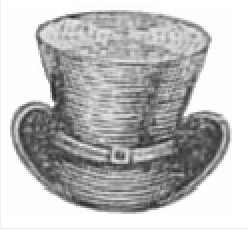 On Oct. 29, 1845, Hopewell advertised in The Hunterdon Gazette his “splendid assortment of the latest Philadelphia and New York styles of Hats and Caps,” with a postscript: “On hand, a handsome assortment of gentlemen’s and children’s fashionable Caps, all of which will be sold at prices which cannot fail to be satisfactory.” He noted that his shop was “situated on Main Street, nearly opposite the residence of Charles Bartles, Esq.” Bartles was located next to the lot on which the Fisher-Reading Mansion was built two years later.
On Oct. 29, 1845, Hopewell advertised in The Hunterdon Gazette his “splendid assortment of the latest Philadelphia and New York styles of Hats and Caps,” with a postscript: “On hand, a handsome assortment of gentlemen’s and children’s fashionable Caps, all of which will be sold at prices which cannot fail to be satisfactory.” He noted that his shop was “situated on Main Street, nearly opposite the residence of Charles Bartles, Esq.” Bartles was located next to the lot on which the Fisher-Reading Mansion was built two years later.
The Hunterdon Militia
By 1844, Hopewell was 30 years old, not too old to get involved with the local militia. The militia had been active in Hunterdon for many years, but by this time there was more enthusiasm as a result of newly tense relations with Mexico and President Polk’s determination to add the Mexican territory of Texas to the United States.7
It was the practice for local militias to gather regularly, partly as a way to encourage discipline and good form and partly as a way to make enlistment appealing. A notice published in the Gazette on June 1, 1842 gives an example of the thorough planning involved whenever the companies gathered. It was signed by Joseph H. Reading, who announced:
GENERAL ORDERS! THE several Regiments composing the Hunterdon Brigade will form line in the main street, Flemington, on Monday, the 6th inst., precisely at 10 o’clock, A. M., fronting East. The 1st Regiment with its right resting in front of Jones’ County Tavern; the 2d Regiment with its right resting in front of the Court House; and the 3d Regiment with its right resting in front of Price’s Mansion House Hotel. The Lambertville Cadets on the right of the 3d regiment. Commandments of Regiments will report themselves to the Brigadier General at Head Quarters, (County Tavern) at 9 o’clock, A. M. By order of the Brig. Gen. [Adam C. Davis].
The Gazette reported on July 31, 1844 that plans were underway for a military encampment to take place at Flemington in August and named a Committee of Arrangements to set things up, consisting of Alexander V. Bonnell, Esq., William Hill and John C. Hopewell. Considering that Hopewell had only been living in Flemington for probably less than two years, he had become an important part of his community in a very short time.
The Committee was directed to “arrange with the different landlords of this village to board the military and to have the exclusive privilege of sutling.” (A sutler followed armies and gathered provisions for them.) The meeting gave the Committee the “power to quarter the companies, unless they shall choose to quarter themselves.” It also chose a name for the encampment—Camp Maxwell, probably after well-known Flemington figure, Col. John Maxwell (1739-1828), and invited the Milford Brass Band to attend. Unfortunately, the Gazette of Aug 28th (the week after the encampment) was so full of notices for Whig meetings, it being a presidential election year, that it had no space to describe the encampment.
Militias were required to assemble at least once a year, which was done in “encampments.” There were many who felt they were more trouble than they were worth, especially since they usually took place during periods when the need for farm work was at its greatest. As it happens, our friend, James N. Reading, was as offended as anyone. I must include this interesting item from the editor of the Hunterdon Gazette (Henry C. Buffington) dated June 11, 1845 (which I failed to include in “Hunterdon’s Militia”):
We are gratified to learn that, with the training at Larason’s [in Ringoes] on Monday of last week terminated, for the present, the ridiculous farce of military musters, within the precincts of the 3d regiment. We learn that the commanding officer, (Col. James N. Reading,) after the muster, stated to the persons assembled, that he had called them together for the last time, until a better law and other regulations should be established. He said he had for some time been convinced of the necessity of a reorganization of the militia system, and he had only been induced heretofore to call out his regiment, in order to draw our full complement of Arms from the U. States—which are apportioned to the different states in proportion to their respective numbers of enrolled militia. But even this consideration, be no longer deemed a sufficient motive, for calling them at a busy season of the year into the field—while the law upon this subject was so inefficient. He had called them out this year against his own inclination, and in compliance with the wishes of some of his brother officers,—but, he had done so for the last time. His remarks met with a hearty response, and such of our citizens as reside within the limits of the 3d regiment are now happily relieved from the performance of this annual burlesque. It might bring our legislators to their senses if other commanders would exercise the manly independence displayed by Col. Reading on the above occasion.
John C. Hopewell kept up his association with the military in its various forms for many years to come. By 1847, he was a Captain serving under Abraham V. Bonnell in “The Union Troop” of Flemington when it met at Reaville, and again in 1848 when it met at Mahlon Hart’s Hotel in Flemington.
A Failed Investment
In the 1840s, copper was found in certain locations around Flemington. Seeing an opportunity, Hopewell joined with John G. Reading and others to form the American Copper Mining Company in 1847.8 But the company offered the property for sale only one month later. It is likely that Hopewell and his partners had discovered that there was not enough copper on the site to justify investing in a mine. That happened more than once at the several copper sites that were discovered near Flemington in the 1850s.
Civic Involvement
John C. Hopewell may have been just a humble hatter, but he must have had a personality that commanded respect. At the Raritan Town Meeting in April 1846, he was chosen to serve as one of the Commissioners of Appeal, along with John Chapman, principal of Flemington Academy, and Atkinson J. Holcombe, a local farmer. And the following June, at a meeting held to plan for the Fourth of July, Hopewell was named to a committee with Henry C. Buffington and Peter W. Burk “to procure an Orator and Reader” (of the Declaration of Independence). Burk was a tailor whose shop was on Main Street; Buffington was the editor of the Hunterdon Gazette; and Hopewell was still a hatter.
Back to Philadelphia
By 1848, John C. Hopewell had restored his credit, but he was not satisfied with the kind of sales he was getting in the still modest village of Flemington, so he decided to move back to Philadelphia where there was more business for a hatter. By March 1848, he had sold his hat stock to William P. Emery, an up-and-coming Flemington merchant. The lot on Main Street that Hopewell had purchased from the Sloans was sold to the editor and publisher of the Hunterdon Gazette, Henry C. Buffington. On March 29, 1848, Buffington announced:
“REMOVAL! THE “HUNTERDON GAZETTE” Printing Establishment has been removed to the building recently occupied by J. C. Hopewell as a Hat and Cap Store, about 100 yards south of the Court House on the opposite side of the street” [my emphasis].
Hopewell was right that he could prosper in Philadelphia, but the move was a tragedy for the family. Not long after they arrived, their daughter Emma Taylor Hopewell died at the age of 21 months.
Back to Flemington
Farmer Hopewell
John and Ann Hopewell were still living in Philadelphia when the 1850 census was taken on October 9th. They were both 37 years old and had five living children. Hopewell was described as a gas manufacturer.
Before the next census was taken on August 22, 1860, the Hopewells had left Philadelphia and returned to Flemington. Snell wrote that Hopewell retired from business in 1854, when he was in his early 40s, which means he did very well while living in Philadelphia. By the 1860 census, his primary occupation was given as ‘farmer.’
Some farming was probably done on the plot of land across from the Dvoor farm, shown on the Beer Atlas (“Coming Into the Station”), but not until 1870, when Hopewell purchased the property from John G. & Sarah Reading.
Hopewell’s farm in the 1850s was located on a 39-acre lot north of Flemington on today’s East Main St., which he bought from Judge Joseph & Elizabeth Brown on Nov. 14, 1853, along with a 2-acre woodlot for $4,800.9
The 1860 census described him as age 46, with real estate worth $25,000 and personal property of $1500. Living with him were wife Ann, also 46, and children Sarah 24, Adelia 21, Mary F. 16, Joseph R. 11, and Charles F. B., age 8. Another member of the household was Benjamin Hart, age 27, employed as a day laborer.
The County Agricultural Society
To say that John Hopewell retired in 1854 hardly seems accurate. He took up farming on his new Flemington property in a fairly serious way and must have been quite successful because in less than two years after becoming a farmer, he was named as a member of the Board of Directors of the Hunterdon County Agricultural Society.
Hopewell continued as a member of the board from 1856 until near the end of his life. In 1860, he succeeded Hugh Capner as President of the Society, a position he held for the next six years.
One of the major events of the year in Hunterdon County was the annual agricultural fair. One can tell how important it was by the coverage it received in the local papers, in which column after column listed the prizes that were handed out for an extremely broad range of agricultural and homemade products. Managing such an event was a big job, so of course, it was usually given to John C. Hopewell.
As related in my earlier article, “Coming Into the Station,” by the 1860s, Hunterdon farmers were finding it profitable to raise a perishable fruit, peaches, for urban markets, taking advantage of the new railroad transport. On May 15, 1868, a public meeting was held at the Masonic Hall on Flemington’s Main Street, as reported by the Hunterdon Republican,
“to co-operate in the movement now taking [place] in other counties on the line of the New Jersey Central Railroad, for raising garden vegetable, berries, etc., for the New York market, and sending milk to said market, and establishing in each county, a farmers’ xchange, and to consider all matters pertaining to the farming interests of the county, and to effect system and organization in advancing said interests.”
As you might expect, John C. Hopewell was the first to sign the notice, followed by John L. Jones, John B. Rockafellow, John H. Capner, Joseph P. Lake, Atkinson J. Holcombe, Richard S. Kuhl, George B. Stothoff, Robert J. Kilgore, George F. Crater, Hugh Capner, Charles Bartles, Joseph H. Higgins, R. Emmans, Amos P. Hunt and James Vansyckel.
It appears that Hopewell was on the alert for ways to improve the lot of Flemington’s farmers. In 1878 he became a director and vice-president of the NJ Live Stock Mutual Insurance Co. There was one exception, though.
One of the matters of most concern to farmers was uninvited hunters tramping across their fields and other acts of vandalism. It was typical of farmers in a given area to join together in a vigilant society to defend their farms from trespass and to punish those who were caught. Much to my surprise, John C. Hopewell was not an active member of the Flemington Vigilant Society, probably the only Flemington organization he did get involved with.
The Militia, Again
In the 1850s, John C. Hopewell resumed his activity with the local militia. In 1857 & 1858 he served as Aide-de-Camp to Brig. Gen. Samuel Lilly.
Those unpopular encampments were still happening; in December 1858, the annual meeting of the Hunterdon Brigade Board took place at Crater’s (the Union) Hotel where “it was resolved that a committee of five persons be appointed to ascertain the probable expense of holding a military encampment in this County, and whether the grounds of the Hunterdon County Agricultural Society, can be obtained for the purpose. The chair appointed Majors Bonnell and Sutphin, Cols. Sutphin and Sergeant and Capt. Hopewell.”10 Given Hopewell’s involvement with the Agricultural Society, it is not surprising that he would be looked to for help on arrangements. He might even have been the one to suggest the location.
Hopewell continued as a Captain and Aide-de-Camp in the Hunterdon Brigade up until the beginning of the Civil War. From that point on, he made regular financial contributions for support of the troops. (He was 47 years old in 1861.)
Hopewell continued as a Captain and Aide-de-Camp in the Hunterdon Brigade up until the beginning of the Civil War. From that point on, he made regular financial contributions for support of the troops. (He was 47 years old in 1861.)
Flemington Presbyterian Church
As soon as he arrived back in Flemington, Hopewell and family rejoined the Flemington Presbyterian Church. It was a popular church with Flemington businesspeople and happened to be the closest church to the Hopewell home.
By 1859, Hopewell was a member of the building committee who were supervising construction of a new church building. Other members were Alexander V. Bonnell, Hugh Capner, Atkinson J. Holcomb, and Wm. P. Emery.
Improving Flemington
Having such a sharp eye for opportunities, it is not surprising that Hopewell would return to Flemington when he did. The Flemington Railroad & Transportation Company had just opened its rail line connecting Flemington with Lambertville and hence, the D&R Canal. This prompted a business boom in the village. But Flemington did not have the infrastructure needed for a sudden increase in business activity.
Having spent those years in Philadelphia, where civic improvements like roads, sidewalks and street lighting were taken for granted, Hopewell could see what poor shape the Village of Flemington was in. It was obvious to him that the town needed, for starters, a “gas works” for street lighting, a safe supply of drinking water, and a fire department.
The Flemington Gas Light Co.
As mentioned above, the Philadelphia census of 1850 noted that Hopewell was running a gas manufacturing plant in the Northern Liberties. This was a relatively new technology, in which coal or wood was “gasified” by heating in ovens with an oxygen-poor atmosphere. The gas that was produced was used primarily for lighting, and became the favored fuel for streetlights, giving a much better light than candles provided, which were in use in urban areas since the 18th century. Hopewell would find this endeavor useful when he returned to Flemington.
It took the partnership of Hopewell and prominent citizen Charles Bartles to gain the necessary charter and get the operation up and running. On July 20, 1859, Hopewell advertised in the Gazette that
“BOOKS will be opened for subscription to the Capital Stock of the Flemington Gas Light Company, at the Hunterdon County Bank, in Flemington, on Wednesday, the 10th day of August next, at 10 o’clock, A. M. [signed] John C. Hopewell, Charles Bartles, John L. Janeway, John G. Reading, and Bennet Van Syckel, Committee.”
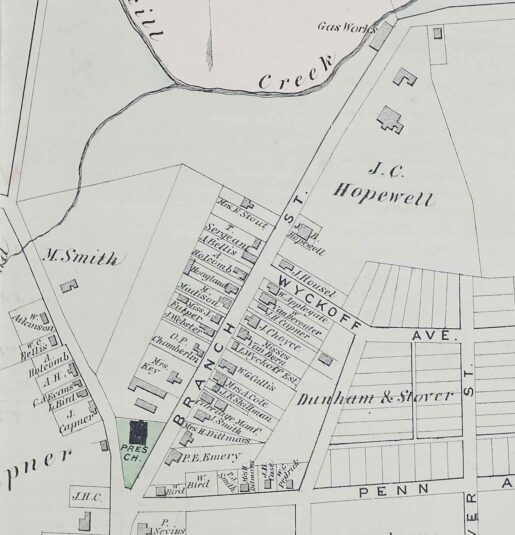 On August 31st, the Gazette crowed: “Gas in Flemington is now a fixed fact. Through the perseverance of Mr. J. C. Hopewell, this enterprise has reached a point beyond failure. Workmen are now engaged in all its branches, and the work will be put through as rapidly as possible.” This obviously included digging trenches in which to lay pipes transporting the gas from the “Gas Works” located on Branch Street (now East Main Street), across from Hopewell’s home, as well as manufacturing and erecting poles and lanterns.
On August 31st, the Gazette crowed: “Gas in Flemington is now a fixed fact. Through the perseverance of Mr. J. C. Hopewell, this enterprise has reached a point beyond failure. Workmen are now engaged in all its branches, and the work will be put through as rapidly as possible.” This obviously included digging trenches in which to lay pipes transporting the gas from the “Gas Works” located on Branch Street (now East Main Street), across from Hopewell’s home, as well as manufacturing and erecting poles and lanterns.
On the same day, notice was given that the Stockholders of the Flemington Gas Light Company would meet in September to choose the first board of directors. John C. Hopewell was named president and continued as such through most of his life. On Sept. 28, 1859, the Gazette reported that
The building of Gas Works, in this place, commenced several weeks ago, and had the weather been favorable, the principal part of the work would have been done before the Fair. A portion of the pipe is already down and the ground leveled. The remainder of the digging will be filled up so as not to interfere with the Fair, and we presume, work postponed for the present week. This improvement to Flemington, is not small by any means, and the greater share of credit, as we have said before, belongs to Mr. John C. Hopewell, who has been untiring in his efforts to bring it about.11
The Flemington Water Co.
Charles Bartles also campaigned for a Water Company for Flemington, to replace the antiquated water system that had existed since 1808, which relied on wooden pipes. Snell wrote that
Two springs, located on John Capner’s and J. C. Hopewell’s lands respectively, were largely the supply in times of scarcity until the water-works were built, water often being hauled form them when wells and cisterns gave out.
Presumably Snell was referring to Hopewell’s farm on the east side of East Main Street. John Capner’s property was on the west side of the street.
Charles Bartles joined up with John C. Hopewell and got charters for both the gas and water companies in 1859. The first officers of the Water Company were Charles Tomlinson, president, and George H. Bartles (cousin of Charles Bartles), secretary & treasurer. Hopewell was a member of the first Board of Directors of the company. Other members of the Board were William P. Emery, Charles Bartles, and Hopewell’s son John B. Hopewell.
When Snell was writing his history in the 1880s, the Directors still included Hopewell and Bartles.
The springs to be used for the new company were located up on the Croton plateau.12 Hopewell supervised construction of the water works (which included the laying of iron pipes and the building of two reservoirs and pumping house).
In Hunterdon County’s financial report for 1867, it noted that it had paid John C. Hopewell for water and gas. Many years later, in 1881, the Hunterdon Republican noted that
“a telephone line is being run from the residence of John C. Hopewell in Flemington, to the Kershow & Chamberlin Mills at the South Branch, a distance of about two miles. It is to be used for giving directions in regard to the pumping of water into the reservoir of the Water Company.”
Flemington Fire Company & and Flemington Fire Insurance Co.
Flemington had a fire company as early as 1842, known as the “Fame Fire Company of Flemington.” But John C. Hopewell was not involved in it, so not much got done, and Flemington residents had to rely on the “bucket brigade” up until 1862.13 The company did not lack enthusiasm, though, as reported in the Gazette of Sept. 17, 1845:
FAME FIRE ENGINE.—A fire company has been formed by the young men of our village, numbering about 20. They paraded with their engine on Saturday afternoon last and presented quite a respectable appearance. They were dressed in red flannel coats, and Tarpaulin hats, with the words ‘Fame, No. 1’ thereon. The hats are similar to those in use among Philadelphia firemen. Our citizens should at once contribute a sum sufficient to purchase an engine, which would be of some service in case of fire. The one we have is a mere plaything—fit only for washing windows!
To protect against such losses, the Flemington Fire Insurance Co., which organized in 1856, was chartered by the NJ Legislature with a capital of $100,000. It was designed “to take risks on all classes of property against losses by fire.” John G. Reading was president of the Board of Directors, which included all the prominent merchants and lawyers in Flemington, among them John C. Hopewell.
The company was organized none too soon. On May 13, 1863, the Gazette reported on a fire in the building it occupied. Fortunately, it was quickly extinguished, but the editor remarked that
This is the second narrow escape of this and enjoining buildings by fire within less than a year. The frightful conflagration in September last, which destroyed the properties of Geo. F. Crater [proprietor of the Union Hotel], Doct. [John F.] Schenck, Anderson & Co. [occupying the old Reading store], and others, is not forgotten, and has caused the citizens to reflect seriously of the necessity of preparing means to meet the destructive element. Mr. John C. Hopewell is already engaged making up the necessary sum of two thousand dollars to construct fire plugs throughout the town and purchase a sufficient quantity of Hose to be able to extinguish any ordinary fire.
The editor, Alexander Suydam, urged people to contribute to the fund for hoses. But in addition, Hopewell was also raising money to purchase a new steam fire engine, which arrived from Philadelphia in August 1864. The Gazette reported on August 24th that the new engine
“was lodged in the house recently erected for it, on Bonnell Street. The machine was accompanied by a hose carriage, and the turnout presented a very creditable appearance, and was enthusiastically greeted by our citizens. The engine is christened “John C. Hopewell,” after one of our leading and most enterprising citizens, to whom our people owe much gratitude for his indefatigable exertions in pushing forward to completion various needful improvements, the most prominent of which are gas and water.”
Not only was the fire engine named after Hopewell, the whole company was named “The Hopewell Fire Engine Company,” and at the election of officers held in November 1864, Hopewell was elected foreman and his son, John B. Hopewell, secretary. Property taxes were not used for its support. The company depended on private fundraising, and the vehicle for that was an annual Fireman’s Ball, which was held at the Court House. (I suppose the pews in the court room were moved to the side.)
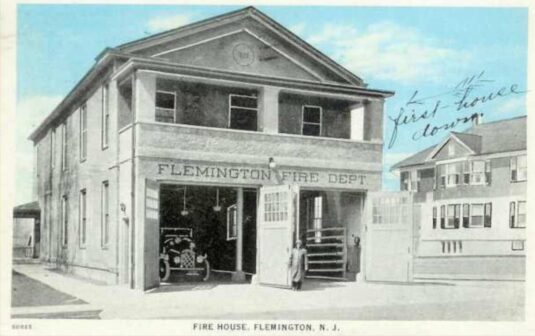 In 1862, a group got together to purchase a steam fire engine and build a two-story building on Lyceum Street (now Court Street) to accommodate it. Among the list of companies and individuals who donated funds for the project were, among the usual suspects, the Flemington Water Works and John C. Hopewell.
In 1862, a group got together to purchase a steam fire engine and build a two-story building on Lyceum Street (now Court Street) to accommodate it. Among the list of companies and individuals who donated funds for the project were, among the usual suspects, the Flemington Water Works and John C. Hopewell.
Two years later, on Dec. 2, 1864, the Hunterdon Republican reported that the “Hopewell Fire Engine Co.” was organized in Flemington on Nov. 26th. The foreman was John C. Hopewell, and his son John B. Hopewell served as Secretary with Richard S. Kuhl assistant secretary.
County Concerns
Gas Works, Water Works and a fire company were not enough to slate Hopewell’s thirst for civic improvement. The Hunterdon Republican reported on May 10, 1867 that the Flemington Building & Loan Association had been created and elected its officers and directors. John C. Hopewell was president with Clarkson C. Dunham, treasurer and Richard S. Kuhl, secretary.
The next year, on May 30, 1868, a meeting was held, probably in Flemington, to discuss ways to promote “the pecuniary interests” of the County. It sounds like an embryonic Chamber of Commerce. George B. Stothoff was appointed Chairman of the meeting and Alpheus C. Young, Secretary. The business committee made a report in favor of the formation of a Stock Company, “according to the prospectus heretofore published.” The following officers were unanimously appointed: President, John C. Hopewell; Vice President, George B. Stothoff; Secretary, Asa Suydam and Treasurer, George F. Crater. Directors were George Capner, William B. Kuhl, Jacob Newell, Samuel Groff, Thomas J. Volk, John Quick, Calvin Pepper, Ferdinand S. Holcombe, Charles Wilson and Albertis [sic] K. Wagner.
Prospect Hill Cemetery
Another local project was Prospect Hill Cemetery. By 1870, the population of Flemington had grown considerably, and it was clear to many that a non-sectarian cemetery was needed. In addition, the cemeteries attached to the Presbyterian, Methodist and Baptist churches in town were probably reaching capacity.
On May 3, 1870, Judiah Higgins, Sr. with Charles Bartles, William P. Emery and John C. Hopewell purchased a tract of 22.48 acres from the estate of John Kee, dec’d. It was located on “the public road from Flemington to Croton,” bordering lands of John L. Jones, John H. Capner, a lot sold to George A. Allen by Charles Bartles, among others. In 1870 that “road from Flemington to Croton” was today’s Capner Street which intersects with Old Croton Road. As it happens, Mr. Kee acquired that property in 1852 from the Flemington Copper Company.
Legislation was required to incorporate the Prospect Hill Cemetery Association of Flemington and was gotten in 1870. The incorporators were, in addition to the men purchasing the acreage, Flemington attorney, Abraham V. Van Fleet.
Street Commissioner
As another indication of the increasing activity in Hunterdon’s county seat, the town of Flemington found it necessary to do something about its streets. In May of 1870, Flemington had its first election for “Street Commissioners,” and Hopewell was one of them, along with Runkle Rea, John L. Jones, Miles Cunningham, Samuel M. Higgins, Abel Webster and Nathaniel G. Smith.
The sidewalks had to be “good sidewalks of either flag, brick or plank, five feet wide. They had to be “in front of and adjoining” most of the properties in downtown Flemington. (The Republican listed all the streets where sidewalks were required, including Branch Street (today’s East Main Street) from the Presbyterian Church up to John C. Hopewell’s property.
The next June, the Commissioners ordered residents to build sidewalks.14 If Flemington’s government today ordered residents to build, or even repair, sidewalks, there would be such an uproar. But that’s how things were done in 1870. If any owners refused to comply, the Commissioners would do it for them at the owners’ expense.
Flemington Railroad
And finally, on July 28, 1870, John C. Hopewell was elected a Director of the Belvidere-Delaware Railroad Company. And on Feb. 29, 1872, he was elected a Director of the Flemington Railroad & Transportation Company. On February 1, 1873, a stockholders’ meeting for the Flemington Railroad & Transportation Co. was held, with Hopewell on the list of Directors, along with other Hunterdon County big shots, like Ashbel Welch, Charles Bartles, Wm P. Emery, Alexander Wurts, and Robert F. Stockton. With a background like that, it is not surprising that Hopewell had nothing to do with the proposed rail line from Prallsville, even though it was planned to run through his backyard. When the scheme fell through, he was probably relieved.
I imagine he was a very popular director. The Hunterdon Republican reported on Dec. 31, 1884, that “John C. Hopewell presented all the employees of the Flemington R. R., which runs to and from Lambertville, a turkey for Christmas.”
Postscript, A Grocery
There was one item concerning Hopewell’s career that had me puzzled, and that appeared in a notice of August 25, 1870 in the Hunterdon Republican of the dissolution of the partnership known as Van Zandt & Hopewell, concerned in “the Grocery business at Flemington.” The notice was submitted by William S. Van Zandt and John C. Hopewell.
It seemed very unlikely that John C. Hopewell would be running a grocery store, and in fact, it was his son Joseph R. Hopewell who was the grocer. The census of 1870 listed him as such, even though he was only 21 years old. It appears that his father had set up the business with William Van Zandt. Joseph R. Hopewell died in 1889 at the age of 40, unmarried. I could not find him in the 1880 census. William Van Zandt was even more elusive, but may have emigrated with wife Sarah Bowne to Rosemond, Christian County, Illinois.
A Remarkable House
 The property that John C. Hopewell purchased from Judge Joseph Brown and wife in 1853 included what was probably a typical two-story, south-facing Hunterdon farmhouse. You can get an idea of what it looked like from this photograph of the rear of the house taken by the Historic American Building Survey (commonly referred to as HABS).
The property that John C. Hopewell purchased from Judge Joseph Brown and wife in 1853 included what was probably a typical two-story, south-facing Hunterdon farmhouse. You can get an idea of what it looked like from this photograph of the rear of the house taken by the Historic American Building Survey (commonly referred to as HABS).
There is reason to think that the house was occupied by Col. Charles Stewart of Revolutionary War fame after his retirement from his plantation ‘Landsdowne’ in Bethlehem township. He died in 1800 at the age of 71 without writing a will. Somehow the property stayed with his heirs until eventually it was sold by one of them to the real estate partnership of Charles Bartles and Aaron Vansyckel, Jr. in 1833, who sold it to Judge Brown the same year.
John C. Hopewell bought the property in 1853, but it was probably not until after the Civil War ended that he made some remarkable improvements, as shown in these two photos.
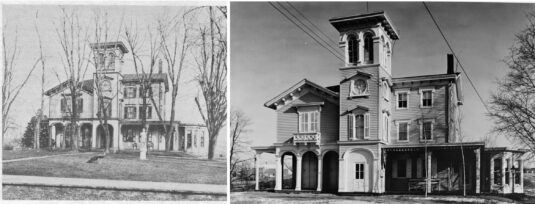 The photo on the right is another HABS photo, probably taken not long before the house was demolished. The photo on the left probably dates to shortly after Hopewell made his additions. Note the peacock on the lawn. (The photograph was shared on Facebook by Raymond Storey; a poorer version can be found in the booklet “Raritan, Flemington & Environs.” Thanks to Ben Zimmer for uniting the two photographs into one.)
The photo on the right is another HABS photo, probably taken not long before the house was demolished. The photo on the left probably dates to shortly after Hopewell made his additions. Note the peacock on the lawn. (The photograph was shared on Facebook by Raymond Storey; a poorer version can be found in the booklet “Raritan, Flemington & Environs.” Thanks to Ben Zimmer for uniting the two photographs into one.)
I would like to defer to the County’s Cultural & Heritage Commission for a proper architectural description, but their survey of historical buildings did not include this one, since it was demolished before the survey was made.
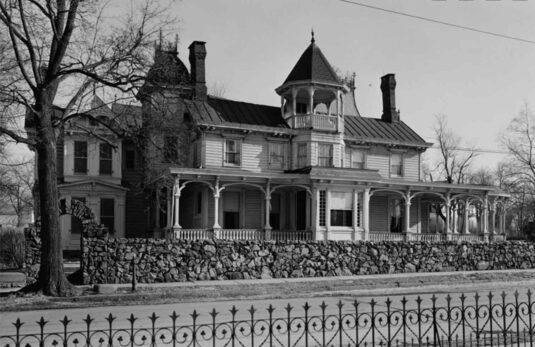 Hopewell was not the only one setting up housekeeping in a grand stye on East Main Street. The well-known property ‘Roselawn’ (left) was created by Hopewell’s contemporary, William Emery, about the middle of the 19th century. I would not be surprised to learn that the same builder worked on both houses.
Hopewell was not the only one setting up housekeeping in a grand stye on East Main Street. The well-known property ‘Roselawn’ (left) was created by Hopewell’s contemporary, William Emery, about the middle of the 19th century. I would not be surprised to learn that the same builder worked on both houses.
It was quite a leap from hatter’s apprentice to the well-to-do and well-regarded gentleman that Hopewell became.
Unfortunately, I cannot write about the contribution Ann Housel Hopewell made because during these years, women were fairly invisible. Her only notice in the Gazette was the awards she received at the county fair. In 1858, her “choice quince and peach preserves” were recognized, and of course, she was only identified as “Mrs. John C. Hopewell.” There was nothing else about her until her obituary was written in 1885, and that said little.
This article summarized Hopewell’s civic engagements but did not include his participation in politics or his involvement with the new bank in town, which were happening at the same time as the activities described here. I am saving those subjects for articles of their own. The next one will examine Hopewell’s membership in the American Party (commonly known as the Know Nothings). After that I will focus on the history of the Hunterdon County National Bank and its beautiful building on Main Street, Flemington.
Footnotes:
- James P. Snell, History of Hunterdon and Somerset Counties, 1881, p.341, with portrait. More information comes from Hopewell’s obituary published in The Hunterdon Republican on May 2, 1888. ↩
- Research into Abraham & Ann Housel has been unsuccessful. The only Abraham I found for this time period lived in Bethlehem Township with wife Esther. Ancestry.com has nothing to offer either. ↩
- However, I must note that the date of 1842 comes from his obituary; I found no other evidence of that. Their son John B. Hopewell was born in Pennsylvania on July 1, 1841. Their next known child, Mary Fabian Hopewell was born in New Jersey on March 20, 1844. ↩
- H.C. Deed Book 82 p.489. ↩
- Chamberlin was mentioned in “A Store, A Bank, A Mansion.” His heirs and his store lot will get more attention in a future article. ↩
- H. C. Deed Book 82 p.489; see also Book 60 p.174 and Book 65 p.414. ↩
- See “Hunterdon’s Militia” for more on the militia companies of the county. Also, highly recommended, Hunterdon County in the Civil War in by John W. Kuhl. ↩
- For more on copper mining on, what else? Mine Street, see “Hill’s Mills at Copper Hill.” ↩
- H.C. Deed Book 107 p.105. ↩
- Hunterdon Gazette, Dec. 22, 1858. ↩
- For more information on the Flemington Gas-Light Company, see an article by Gerald E. Zich in the Hunterdon Democrat, a copy of which can be found in Hunterdon County Historical Society Archives, folder #79, Box 4 of Bush Papers, Collection #83. ↩
- Snell wrote that the property was purchased by the Flemington Water Company, but if so, the deed did not get recorded. ↩
- Snell, History of Hunterdon County, p.335. ↩
- Hunterdon Republican, June 2, 1870. ↩